
All categories
Featured selections
Trade Assurance
Buyer Central
Help Center
Get the app
Become a supplier

(643 products available)


































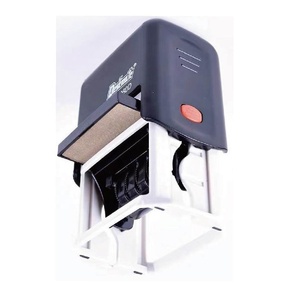
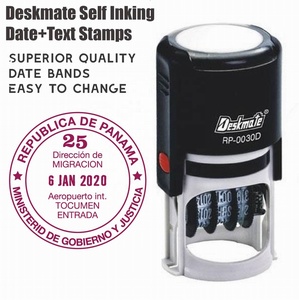
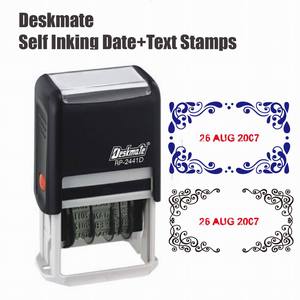
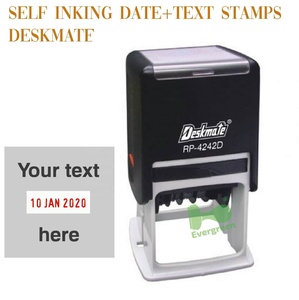
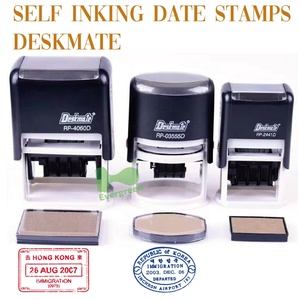
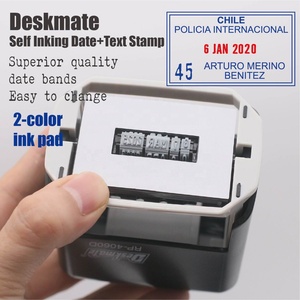
There are numerous kinds of received stamps, and they differ according to numerous things, including the impression's shape, the text contained, the volume of use, the materials used, and the designs. Below is a description of each type of stamp, including where it is likely to be used most often as well as its main characteristics.
Because of its flexibility and durability, rubber is one of the most commonly used stamp materials. It is of particular interest to people or organizations that regularly require received stamps of different impression sizes and types. This is because the character plates are mounted on a central plate that contains the messages, and the messages can be rearranged to produce different Received impressions.
These stamps are also referred to as self-inking stamps. They were created using a built-in ink pad that automatically re-inks the stamp after each impression. This makes it more convenient than traditional rubber received stamps, as the post officer or other users do not have to manually ink the stamp. A common line of business stamp, these are compact and very useful for making quick repetitive received impressions on documents.
If offices require stamps in large volumes, they should use received stamps in large impressions. These stamps usually contain an automated functionality that self-inks the stamps after each impression is made so that the stamps can be used efficiently. High-capacity models are generally built to allow frequent usage without wear and tear on the equipment.
Custom received rests allow their users to modify the text on the impression to suit specific requirements. Certain organizations may need distinct received impressions for numerous departments such as Human Resources or Legal. Custom stamps can be created to the size of the impression required and words on the impression to fit specific needs. This makes received supplies stamps highly flexible.
The design of received stamps is important in enhancing their functionality apart from improving their aesthetic appeal. This is because users basically have to pay close attention to certain design aspects in order to get the stamp that will meet efficiency and practicality requirements. Below are some key design elements.
The Received impression's length is directly related to the clarity and visibility of the impression on any document. Received stamps are available commercially in different sizes and shapes. Round received stamps are larger than the square received stamps, and this is so especially in offices that need a large Mb of��clarity on the documents. However, larger impressions make it very difficult to�fit the stamps into dense areas of text since it will not be possible to read the information that has been printed. On the other hand, smaller impressions, though more difficult to read, can be easier to fit into dense documentation and are thus better for use in such situations.
The durability and comfort of the stamp are affected by the material that goes into making the handle. Received stamps can easily be wooden, plastic, or metal. Wooden Made stamps have a vintage feel but do not guarantee lifetime usage, unlike metal stamps; plastic handle stamps are cheap and quite handy, but metal stamps have a lifespan of over 10 years and are durable. Basically, cheap and handy plastic stamps are not always durable, and though expensive, the metal stamps are the most so convenient for offices and other businesses looking for the durability of the stamps.
Further, received stamps can be custom-made to incorporate unique text elements such as department names or even organization logos. This is particularly important for branding as it creates a sense of uniformity within an organization. Custom received supplies stamps can also be utilized for various departments in an organization, such as human resources or finance. This creates an impact out of documents when they pass through either department. This is useful because it also prevents the documents from mixing each other up pretty easily with crime stamps for each department.
Diverse ink types should probably be used with diverse stamp uses in mind, and each ink type seems to have its own merits as well as demerits. Commercial ink pads can be re-filled with either oil-based or water-based ink that comes in a variety of colors ranging from red to blue, black, and even green. It is recycled from renewable resources and is eco-friendly. A water-based ink pad is cheaper and easier to find. Just adding this information for friendly reasons, but there is no ink pad in the following sentences about received stamps that can surpass the versatility and the wide acceptability of commercially available ink pads.
Received stamps can be used in different commercial cases to ensure that all legal and procedural requirements are met when handling documents. Moreover, to avoid ambiguity, received stamps have to be used to achieve clarity on documentation for specific types of business. Below are normal scenarios.
Law firms often deal with large cases of documents that need either chronological organization or specific handling. In such scenario, received stamps can be used to classify and archive time-sensitive documents such as contracts or briefs. These are classified stamps that put on a document when the document has been received, and this helps in the storage and retrieval within strict legal contexts.
Corporate environments also generate massive Mb of documents that often need clarity as they are processed through different departments. Another business solution is received stamps, which are convenience and order to set clarity among documents in motion between departments or within a department. For instance, a set of documents earmarked for the finance department may be stamped as received by the department four days ago and then created for infusion in the department.
Schools and colleges receive applications, transcripts, and a host of other documents. To effectively process these documents, clarity is paramount. Received stamps can conveniently bytes be used to denote the reception status of documents in various institutional Library boards, Admission offices, or Registrars.
Shipping companies really need to have received and delivery stamps that will help them keep track of the packages. It is also convenient to place received stamps as a practical means of tracking shipments, thus eliminating confusion between incoming and outgoing shipments. Received stamps can be applied to invoices in the case of local transportation or to other tracking documents in the case of large shipments of statistical requisition.
Received stamps are often used by government offices in the handling of documents such as applications, permits, and public requests for information. These stamps assist Agencies in the documentation queues that have to be dealt with in order to meet public service requirements. Examples include records of received citizen complaints and applications for permits in documentation queues that require dealing with them in order to meet public service requirements.
Knowing and even bearing specifications for received stamps considered is very vital, as is maintenance and longevity. Here specific details buyers should pay attention to when purchasing a received stamp and how to care for it to remain in good shape for as long as possible.
Received stamps can perform efficiently with a stamp pad ink created for optimal received stamp performance. This is because both water-based and oil-based inks are available, each with a certain level of affinity for certain tissue types. While Water-based inks are organic and hence ideal when stamping documents for the archives or legal proceedings, oil-based inks are pigment-based for their ecological friendliness and therefore endure usage on various tissues.
Received stamps are constructed using materials of diverse strengths, including metals, plastics, and rubber. Rubber is said to be one of the strongest materials used to produce stamps because of its elastic; hence, it will not shatter after several uses. Hard-wearing phrases are crafted in metal frames, whereas plastic frames are wooden: affordable but do not last as long as metal frames.
Custom received stamps are useful if specific message requirements are needed on the impression. These impressions can also vary in size, depending on the amount of text that needs to go onto the impression. What is crucial, though, is that well-cared-for and accurate stamps bring about continuity with each impression and give continuity in convenience and efficiency when processing received documents by the organization.
This means that stamps should be cleaned on a regular basis, preferably every time after use, to get rid of the leftover ink from the impression. Use damp wipes or special stamp cleaning solutions, and don't use anything rough: this will keep the impression clean and make it last longer. The ink pad should also be cleaned and replenished with ink from time to time, depending on the frequency of usage.
Store stamps in a cool area, shielded from direct sunlight. This helps in the long run because of the different materials that were used in the making of the stamps and because of the ink that was used on the stamps. This is because when exposed to light and high temperatures, the different materials and inks used to make the stamp will degrade. Received stamps should, therefore, be kept in a cool, dark box away from direct heat or light.
Answer 1: Yes, received stamps can be used repeatedly until they show signs of wear or damage. Proper maintenance and storage will prolong their lifespan.
Answer 2: Yes, received stamps can be customized to include specific text, such as department names or organization logos, for more personalized use.
Answer 3: To clean received stamps, use damp wipes or a specialized stamp cleaning solution. Harsh materials should be avoided to prevent damage.
Answer 4: The ink type used for received stamps depends on the surface being stamped. Water-based inks are ideal for porous surfaces, while oil-based inks are better suited for non-porous surfaces.
Answer 5: Larger impressions offer more clarity but can obscure important text, while smaller impressions fit better in tight spaces but may be harder to read.